Search Results for: It
Two years in the making, the definitive book on writing dialogue is finally here. You can buy the e-book RIGHT NOW over on Amazon. Those of you who receive my newsletter already know this (if you want to sign up, e-mail me at Carsonreeves1@gmail.com). The rest of you? What are you waiting for? It’s only $9.99, which gets you an unheard-of number of dialogue tips. A lot of these tips are things you can start applying immediately to improve your dialogue.
If you’ve already purchased a book, go write a review. Love it or hate it, it helps! I want to share all this knowledge I’ve accumulated with as many people as possible. So go get it!
One more announcement. This month is Tagline Showdown. Every month, I do a logline showdown. You send in your title, genre, and logline for your script. I post the best five loglines on the site. People on the site vote for their favorite. The winning logline gets a script review the following week.
This month we’re adding a twist! In addition to the usual information, you’re also going to send in your movie tagline. A movie tagline is the fun line they put on the poster. For example, The 40 Year Old Virgin tagline is, “The longer you wait, the harder it gets.” Army of Darkness: “Trapped in time. Surrounded by evil. Low on gas.” Memento: “Some memories are best forgotten.”
Start sending in those entries. Here are the details on how to submit!
What: Tagline Showdown
I need your: Title, Genre, Logline, and Movie Tagline
Competition Date: Friday, April 26th
Deadline: Thursday, April 25th, 10pm Pacific Time
Where: Send your submissions to carsonreeves3@gmail.com
Week 13 of the “2 Scripts in 2024” Challenge
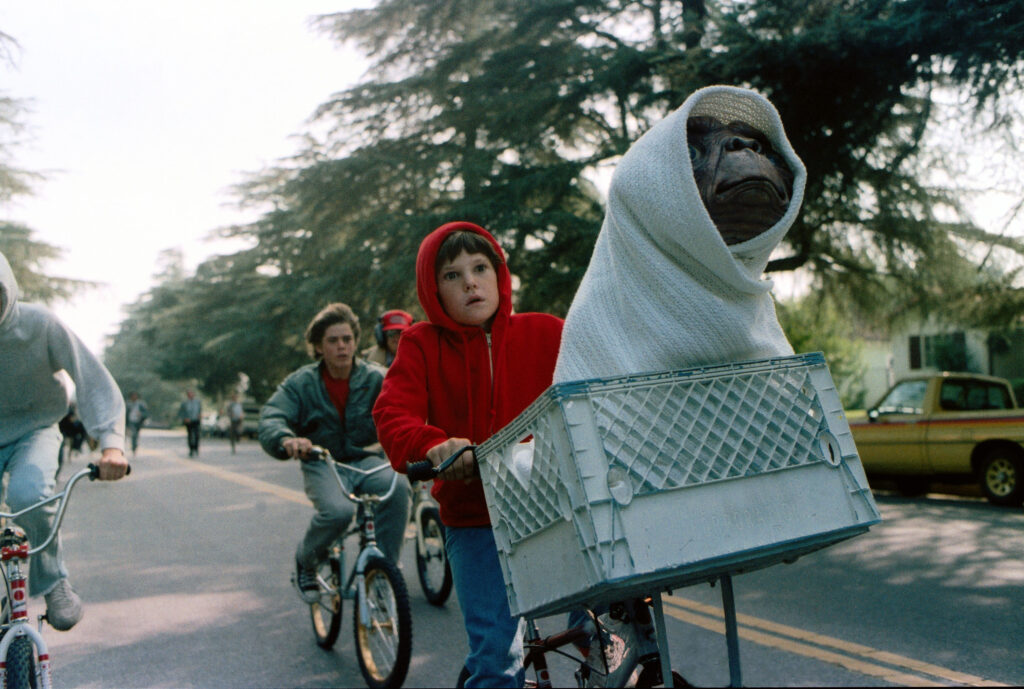
Week 1 – Concept
Week 2 – Solidifying Your Concept
Week 3 – Building Your Characters
Week 4 – Outlining
Week 5 – The First 10 Pages
Week 6 – Inciting Incident
Week 7 – Turn Into 2nd Act
Week 8 – Fun and Games
Week 9 – Using Sequences to Tackle Your Second Act
Week 10 – The Midpoint
Week 11 – Chill Out or Ramp Up
Week 12 – Lead Up To the “Scene of Death”
As I was ramping up to write today’s screenplay lesson, I stumbled upon a recent quote from Jonathan Nolan, who’s going through the press tour in the leadup to his new Amazon show, “Fallout.”
Nolan is the writer-director who made HBO’s Westworld.
A big topic of discussion around town is the condensing of television writing jobs because there have been too many shows and nobody’s watching most of them. So they’re cutting down shows and that means less jobs.
So everyone’s trying to learn LESSONS from this “Peak TV” period that just passed. And here’s what Jonathan Nolan had to say about it: “If the lesson was to ease back on complexity or weirdness, I don’t want to learn that lesson.”
I can’t emphasize how angry this quote makes me. Because Jonathan clearly doesn’t understand the difference between complexity/weirdness and making weak creative choices. He thinks, as long as he’s not making the obvious choice, that’s “good.”
But that’s only the first half of the equation. The second half is the quality of the choice itself. The choice actually has to be strong enough to create good story threads! It can’t just be different for different’s sake. The reason Westworld became unwatchable was not because it was too complex or too weird for the average viewer.
People stopped watching that show because the writers, which included Nolan’s wife, repeatedly made weak creative choices that turned the narrative into a slog.
Every story has a “work/reward” ratio to it. As long as the rewards are bigger than the work, we’ll keep watching. But the second the work we have to do becomes bigger than the rewards? That’s when we say ‘seeya.’ Which is exactly what happened with that show.
And this is when it struck me that there’s really only one lesson in the entire screenwriting skillset that matters. There’s only one thing you have to do. What is that thing?
MAKE THEM CARE ABOUT WHAT HAPPENS NEXT.
That’s all that matters. The second the reader no longer cares about WHAT HAPPENS NEXT, they’re out. Whether they physically stop reading or mentally stop investing, they’re no longer interested in your story.
Therefore, every creative choice you make in screenwriting should revolve around that rule: “Does this make the reader care about what happens next?”
Cause if it does, THEY WILL WANT TO KEEP TURNING THE PAGES.
That’s what we want them to do, right? We want them to keep turning the pages.
I’m sorry for being rude but when you’re talking about nepotism, a strong argument can be made that Jonathan Nolan is the biggest beneficiary of nepotism in all of Hollywood. And if I’m wrong? Prove me wrong. Who’s gotten more from less talent out of their Hollywood family connection?
But let’s get back to this concept because I want this to be flashing in your head whenever you’re writing. Whether it be now, in pages 81-90, or any section of the screenplay.
Does what I’m writing make people want to find out what happens next?
Obviously, there’s subjectivity at play here. But you’re better at evaluating weak creative choices than you think. One of the most common things that happens when I do screenplay consultations is I’ll send the notes back to the writer and they’ll say to me, “I had a nagging feeling that this was a problem but I needed to hear it from someone else.”
You know. You always know when you make a weak choice.
What do I mean by weak choices? Well, let’s talk about a key choice that affects the end of a classic script, since that’s what we’re talking about today. Did you know that in the original Back to the Future script, the time machine was a stationary refrigerator in a junkyard?
In subsequent drafts, they turned it into a car.
I want you to think about those two creative choices for a second. Because each version leads to vastly different story endings.
In one, our characters have to run back to a junkyard. How interesting is that?
In another, they have to meticulously time a time machine on wheels to hit 88 miles per hour at the very second that a lightning strike occurs.
It’s the creative difference between night and day.
That’s what strong creative choices can do for your screenplay.
I was just talking to a screenwriter about this. Their ending was pretty good. But it didn’t push the envelope enough. The stakes didn’t feel big enough. The obstacles didn’t feel insurmountable enough. The goals felt sufficient but far from exciting.
The ending is where you have a chance to create MAGIC. You’ve been writing this entire story for this moment so don’t get careless here. This is where you have to land that triple axel. And it starts with writing creative choices that make your ending EXCITING and not just a copy of the endings you’ve seen before.
Cause when I look back at Back to the Future, I never saw an ending like that BEFORE. And I’ve never seen an ending like it SINCE.
All of this is to say that you’re trying to come up with bold exciting creative choices that MAKE US WANT TO SEE WHAT HAPPENS NEXT.
So what does happen next in pages 81-90, since those are the pages we’re on now? As we discussed last week, this is your MOMENT OF DEATH.
In a 110 page script, somewhere between pages 82-86, THERE MUST BE DEATH. I think Blake Snyder’s beat sheet calls this the Dark Night of the Soul? Whatever you call it, it’s got to be the second lowest moment in the character’s entire journey. The lowest moment will come just 15 pages later when they take on the bad guy and the bad guy seemingly defeats them. That will be their ACTUAL lowest point in the story.
But this one’s pretty darn close. The way you want to look at it is, this is the moment where the reader should feel like, “That’s it.” There are no other options. The hero has lost. This should be so convincing that EVEN THOUGH the reader knows there are 25 pages left, EVEN THOUGH seasoned moviegoers sense there are still 25 minutes left, you’re SO CONVINCING in this moment, that we truly think it’s over. If you can achieve that, you have NO IDEA how exciting your ending will be.
Because one of the secret tricks of screenwriting that makes readers feel something deep, is when you bring them ALL THE WAY DOWN and then you bring them ALL THE WAY BACK UP AGAIN.
I remember the moment I learned this lesson – although I didn’t understand it at the time. But when I first watched E.T. as a kid, and E.T. dies in that end of the second act moment… I don’t know if I’ve ever been more devastated in a theater. I was a wreck. So when they then brought him back to life??? That rush I got from going all the way from the depths of story misery to the peak of story euphoria – I wouldn’t be surprised if that feeling I had that day had something to do with me pursuing this art of storytelling. Because I wanted to learn how to make other people feel that way.
So figure out how to bring your hero down to his lowest low. It could be the death of a close family member or friend. It could be their own death. Or it could just feel like there are no other options left. I highlighted Life of Pi last week and that’s a good one. There’s this moment late in that movie where their sails are broken and they’re in the middle of the sea and they’re starving and they’re dehydrated and it’s clear that there’s no one who’s going to save them.
You kind of have to be a sadist in this moment. You have to be cruel to your heroes. To TRULY set the tone of how destitute they were, the writers of Life of Pi added a distant cargo ship. Their LAST HOPE. And they watch helplessly as it chugs on, never seeing them. Think about how hopeless you would feel after that moment.
That’s what you want to do to your heroes at the end of the second act. And that’s the same feeling you want the reader to have. That’s your pages 81-90 homework. :)
JUST TWO MORE WEEKS LEFT!
And then we move on to our rewrite strategy. :)
Week 12 of the “2 Scripts in 2024” Challenge

We are writing a screenplay! And, believe it or not, we are almost done with our second act. You deserve a ribbon for that alone. Cause most writers never make it out of the second act.
If you missed out on previous articles in this series, I’ve listed them below.
Week 1 – Concept
Week 2 – Solidifying Your Concept
Week 3 – Building Your Characters
Week 4 – Outlining
Week 5 – The First 10 Pages
Week 6 – Inciting Incident
Week 7 – Turn Into 2nd Act
Week 8 – Fun and Games
Week 9 – Using Sequences to Tackle Your Second Act
Week 10 – The Midpoint
Week 11 – Chill Out or Ramp Up
If you’re at page 70 and are new to this screenwriting game, you’re probably intimidated as F&%$. I don’t blame you. It’s scary. We’re in no man’s land right now. But don’t worry. Based on our 110 page screenplay length, we’ve got only 15 pages left before we segue into our third act.
We’ve been covering the second act for a while now so it’s a good time to remind you what the five major components of the second act are.
- Hero should be moving towards their goal.
- You need to throw many obstacles at your hero to make pursuing that goal difficult.
- Explore unresolved relationships.
- Explore how your hero’s primary flaw is getting in their way.
- Move secondary character subplots forward (if you have them).
As long as you’re doing one of those five things, you’re moving in the right direction. The only difference between how you address those things NOW, towards the END of the second act, as opposed to the beginning of it, is that now everything is more intense.
Achieving the goal seems to get harder every second.
The obstacles only get bigger.
The relationships feel like they’re on the brink of extermination.
Your hero’s flaw is eating them alive, getting in the way of everything.
The subplots are all coming to a head.
But let’s get more specific.
What we know about the end of the second act is that it’s where our “DEATH SCENE” is. Not literally (although it can be). But the idea with the end of the second act is that our hero will have tried EVERYTHING to achieve his goal. And yet, he’ll have unequivocally failed. This is when both the protagonist and the audience should feel like “WE’VE LOST.”
So if we back up fifteen pages from that moment, we have to ask ourselves, “What leads up to that lowest point?” And usually, it’s when your hero has put in their BIGGEST PUSH. Or, at least, the biggest push they believe they’re capable of in this moment in time.
Due to them not yet overcoming their flaw, this late push doesn’t have the full force that our hero is capable of once they do overcome their flaw (which will happen in the climax).
The easiest genre to use to figure out how this works is the Romantic Comedy. We know that the boy is going to lose the girl at the end of the second act. That breakup is the equivalent of death. We see this in The 40 Year Old Virgin. Andy gets in a fight with Trish because she’s frustrated that he keeps avoiding sex. So she storms out, effectively ending their relationship.
So, how do we ramp up to that? We ramp up to that by writing scenes where Andy has opportunities to have sex with Trish but keeps backing out of them. They go on a date. The chemistry is off the charts. They get back to her place. It gets hot and heavy. But then Andy freaks out (cause he’s never had sex before) and makes up an excuse to leave. This makes Trish self-conscious and now she’s starting to doubt whether Andy is attracted to her.
Whenever you’re unsure what scene to write in a script, always go back to the character goal. The character goal will give you your answer. Because, chances are, you need to write a scene that brings you closer to that goal being achieved.
By the way, The 40 Year Old Virgin has a TON of secondary characters. So, much of its late second act is dedicated to covering those storylines. This option is available to you during this segment of the script if you have lots of subplots.
Let’s switch up the genre. In one of the best action movies ever, Predator, the end of the second act is everybody dead except for Dutch (Arnold Schwarzenegger). So, if you back up 20 pages, how do we get to that point?
We get to that point because Dutch and the three remaining survivors are making a run for it. That’s one of the interesting things about the goal in this movie. The goal isn’t to beat the Predator. It’s to escape it. But the Predator tracks the final four and kills them off one by one. So those are the scenes you would write in this section.
In the movie, Life of Pi, which follows a boy and a tiger stuck on a boat together, the end of the second act is them finally getting to land and the tiger jumps out of the boat and runs off.
Although the tiger doesn’t die, it is the equivalent of death for the boy because that tiger is who helped him get through this nightmare of being stranded at sea. And now it’s as if he was never there in the first place.
So you need to ask, what gets us to that point? Well, what’s the goal? The goal is to find land. The scenes that David Magee writes are the boy, Pi, trying to stay motivated. He’s stuck out in the ocean. His sails are busted. He literally can’t move. So the scenes are about looking for meaning in order to keep going.
One of those scenes has a major storm come (A GIANT OBSTACLE!) and essentially kill the tiger. The tiger is lifeless the next morning. Pi then nurses him back to health. It’s not as clear as Predator where our characters are physically moving towards their goal (escape the Predator). But because getting to land requires staying motivated, the goal is simply to find a reason to keep going. For Pi, that motivation is his tiger (Richard Parker).
The big lesson here is that you’re moving towards that DEATH at the end of the second act. So you want to go full-throttle towards that death. Whether it’s characters running away from a killer alien, a giant storm that nearly wipes out your hero and his tiger buddy, or your romantic interest pushing your hero towards something they’re terrified of doing.
Put your foot on the gas. Because in 15 pages, you’re going to hurl your hero into a spectacular crash you masochist!
:)
An excerpt from my upcoming book, “The Greatest Dialogue Book Ever Written”
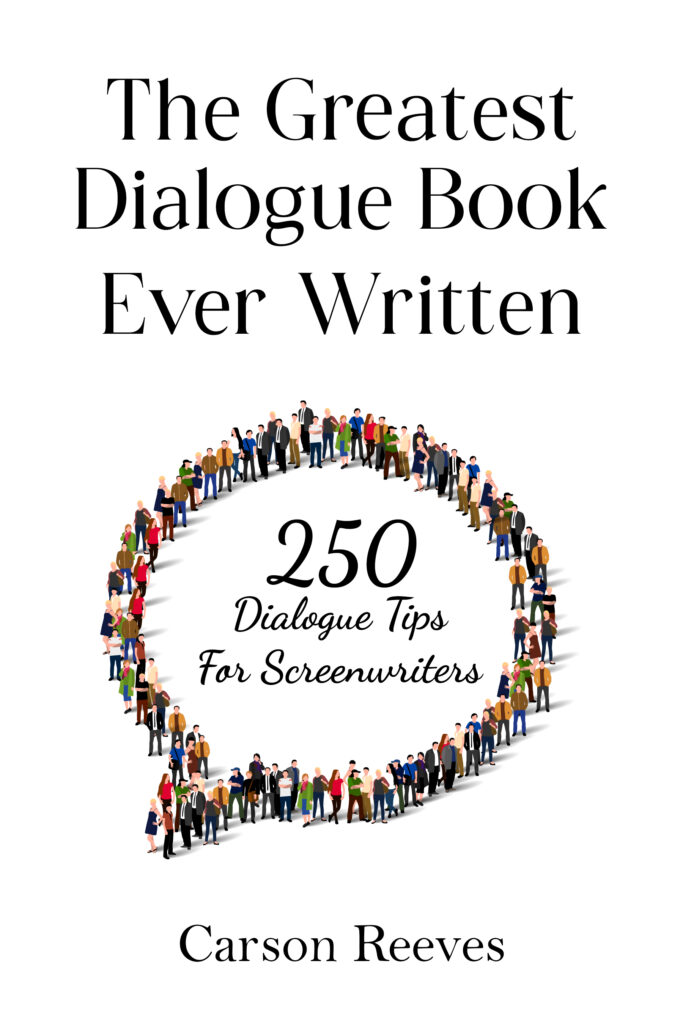
There was a time when I didn’t think I was ever going to finish this book. There were too many technical obstacles (mainly regarding how ebooks interpret screenplay-formatted text) that required endless troubleshooting. But I’m SOOO excited that I’m finally about to release the book because I truly believe it will be the seminal book on dialogue for the next 50+ years.
It’s a book with 250 dialogue tips. This in an industry where you’re lucky to find someone who can give you 10 dialogue tips. And I just can’t contain how thrilled I am that I can finally share it with you. I already posted the opening of the book the other week. In today’s post, I’m including a segment from the “Conflict” chapter. This is arguably the most important chapter in the book and it contains 21 tips total.
TIP 121 – Make sure there’s conflict built into the relationship of the two characters who are around each other the most in your movie/show – Who are the two characters who will be around each other the most in your script? You need to build conflict into the DNA of that relationship specifically. That way, almost every scene in your movie is guaranteed to have conflict. John and Jane in Mr. and Mrs. Smith, Tony Stark and Steve Rogers in Civil War, Allie and Noah in The Notebook, Lee and Carter in Rush Hour, Danny and Amy in the Netflix show, “Beef.”
TIP 122 – Using worldviews to create conflict – Okay, but how do you build conflict into the DNA of a relationship? One way is to give characters different worldviews. Have them see the world differently. If you do this, your characters will be at odds with each other for an entire movie as opposed to one or two scenes. In the Avengers movies, Tony Stark’s worldview is he’s willing to get dirty to protect the universe. Steve Rogers’ worldview is governed by honesty. He wants to play by the rules. That difference in their worldviews is why the two butt heads so much.
TIP 123 – Embrace the word “NO” – “No” is the OG conflict word. Without it, most conversations become boring. Let’s say your hero tells his wife, “I’m going to the store,” and she replies, “Okay.” How is that going to result in an interesting conversation? Or your assassin asks his handler, “Is it okay if I skip this assassination? I don’t think it’s safe enough.” And the handler replies, “Sure, no problem.” When people agree with people, the conversation immediately stops. This is why you want to integrate “No” (and all forms of it) into your dialogue. Here’s an example from the HBO show, White Lotus. In it, 23 year old Albie has fallen in love with a local Italian prostitute who owes her pimp money. Albie wants to help pay her pimp off, so he comes to his rich father to ask for money.
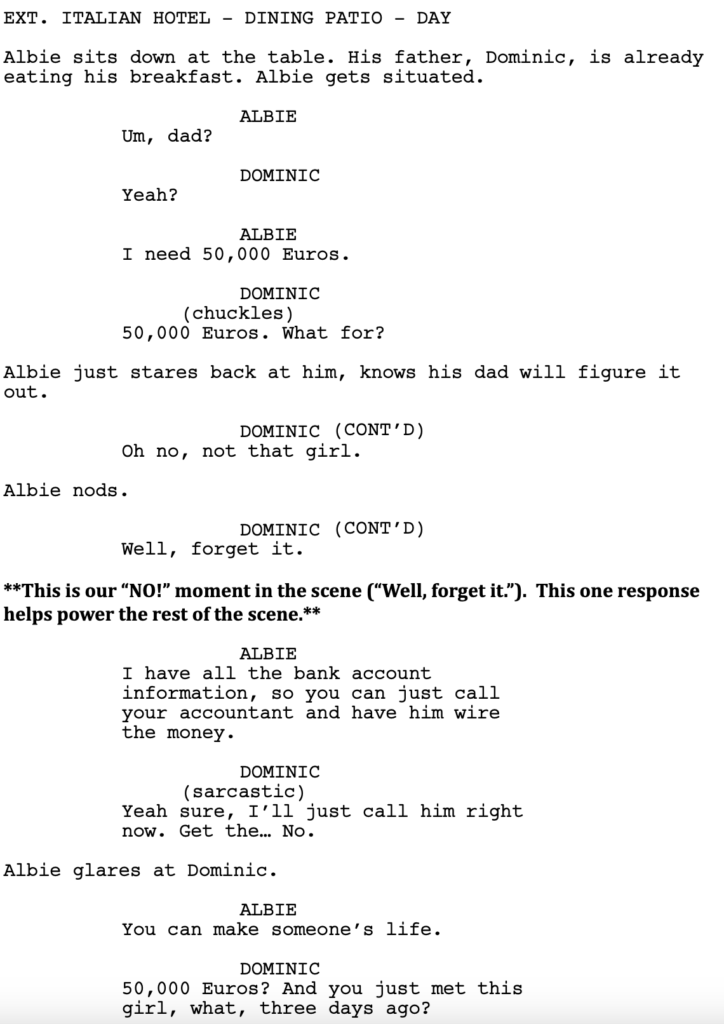
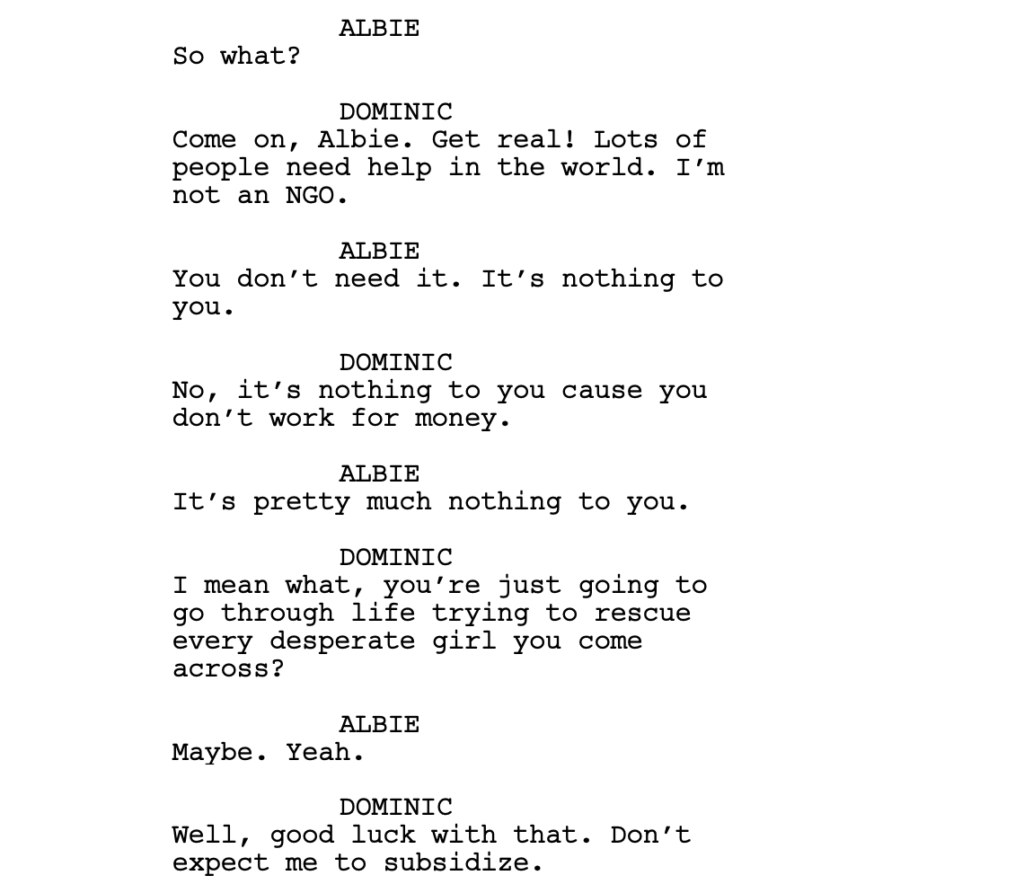
TIP 124 – Make them work for their meal – The reason “No” is so great for dialogue is that it forces your character to work for their meal. They don’t get a free pass. The above scene goes on for another three minutes and Albie has to resort to offering something to his father to get the money. That’s what makes the scene entertaining – that he has to work so hard for his meal. And he wouldn’t have had to do it if his dad had said, “Yes.”
The Scriptshadow Dialogue Book will be out within the next two weeks. But there’s a chance it could be out A LOT SOONER. So keep checking the site every day! In the meantime, I do feature script consultations, pilot script consultations, short story consultations, logline consultations. If you’ve written something, I can help you make it better, whether your issues involve dialogue or anything else. Mention this post and I will give you 100 dollars off a feature or pilot set of notes! Carsonreeves1@gmail.com
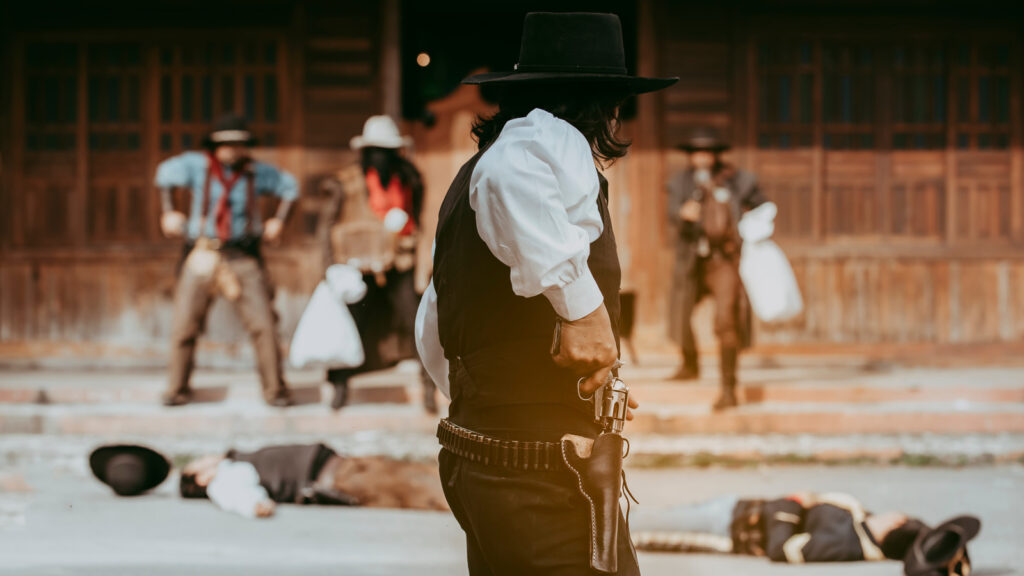
Tis here!
Movie Crossover Showdown, baby!
We learned that just this weekend, the seemingly impossible-to-please Lucasfilm head, Kathleen Kennedy, greenlit The Acolyte based almost entirely on this movie-crossover pitch: “Frozen meets Kill Bill.”
It goes to show just how powerful movie crossover pitches can be in this business. Something about the right one CLICKS with readers. There have, for sure, been instances when I was on the fence with a logline and a cool movie-crossover pitch sold it for me.
Alas, I quickly learned from the entries that movie-crossover pitches aren’t as easy as they seem. I got a lot of entries where one of the movies in the pitch WAS A BOX OFFICE FAILURE. Never ever pitch movies that did poorly at the box office. Or even neutral. They have to be big box office winners or major awards winners.
Also, I got a lot of movie crossovers that were basically the same movie! I.E. “Joker meets Taxi Driver.” The power of the crossover is that you’re pitching two movies that aren’t the same, however, when combined, create something that sounds exciting.
I also encountered several entries that included very obscure movies. You might get some points in your film school class for including “Why Does Herr R. Run Amok?” in your pitch. But it’s not going to get anyone to read your script.
With that said, there were some really fun entries! The hardest part was when someone had a strong crossover pitch but the logline itself didn’t hold up. One of my favorites was, “THE SILENCE OF THE LAMBS meets THE ANDY GRIFFITH SHOW.” That was great. And there were others. So I want to thank everyone who took the time to send their pitches in. If you didn’t make the cut, feel free to offer your pitch in the comments for feedback.
Again, guys, when you’re cold-querying people, a great movie-crossover pitch could be the difference between them requesting the script and not requesting it. So this is important!
We have some very movie-friendly ideas this month. Maybe more so than ever before in Logline Showdown. These ideas are big and they’re sexy.
As far as how you should vote, I want you to vote on the whole package! The logline should still be the focal point of your vote. But if a movie-crossover pitch helps elevate that logline, that should factor into your vote!
If you haven’t played Logline Showdown before, read all the entries below and then, in the comment section, vote for your favorite. The entry that gets the most votes receives a script review next Friday. If you have extra time, tell us why you voted and why you didn’t vote for the others.
You have until 11:59pm Pacific Time Monday Night to vote.
May the best logline win!!!
ENTRIES
Title: Recursion
Genre: Action/Fantasy
Logline: A female reporter desperate to rescue her kidnapped friend from a Tijuana drug cartel, teams up with a mysterious man who claims to be stuck in a time-loop – where every day ends in his death.
Movie-Crossover: Sicario meets Edge of Tomorrow
Title: Goblin In Love
Genre: Family/Animation
Logline: A young goblin travels with his friends across a suburban fantasy world to meet the love of his life – a fairy who’s he only ever seen in one social media post.
Movie-Crossover: ONWARD for the TikTok generation.
Title: INHUMAN
Genre: Sci fi Horror
Logline: An estranged married couple get attacked by three psychotic men who claim the wife has been replaced with an alien clone and they must kill her to prove it…
Movie-Crossover: The Strangers meets Invasion of the Body Snatchers
Title: Lockdown at Hell High
Genre: Horror
Logline: Twenty years after a tragic shooting, a high school reopens with state-of-the-art security, only to find history repeating itself when students are “locked down” with a sadistic killer using the technology against them.
Movie-Crossover: Riverdale meets “Saw.
Title: ECSTATIC
Genre: Drug Dramedy
Logline: In 1985 Dallas, a young psychotherapist discovers a new drug that could be a life-saving treatment for PTSD, but she falls for the DEA Agent tasked with finding evidence to ban this abused club drug nicknamed “Ecstasy.”
Movie Crossover: What if TRAINSPOTTING partied with ERIN BROCKOVICH?
I said I would include one entry this week SOLELY on the movie-crossover pitch, regardless of the logline. Here is that winner. And to be honest, it wasn’t close!
Title: She’s Got Claws
Genre: SUPERNATURAL THRILLER
Logline: A young war widow awakens naked on an Alaskan military base and fights for survival as she’s hunted by her father’s vengeful soldiers after a whole platoon was ripped apart overnight.
Movie-Crossover: American Werewolf In London eats Memento
